Last Tuesday night, my 6-year-old asked me to read “just one more story” for the fourth time. As I watched her eyelids finally get heavy during a tale about a sleepy hedgehog, I realized something: the right bedtime story isn’t just about getting kids to sleep—it’s about creating those magical few minutes where the whole world slows down.
short bedtime stories
I recently discovered that only 46% of young American children regularly receive bedtime stories, and honestly, it shocked me. Growing up, bedtime stories weren’t just entertainment—they were the bridge between our busy days and peaceful nights, creating some of my most treasured childhood memories.
You know that feeling when you’re exhausted, your kid is wired, and you just grabbed the first book you could find? I’ve been there. I once tried reading an action-packed superhero story at bedtime—big mistake. My daughter was bouncing off the walls until 10 PM. The challenge isn’t finding bedtime stories; it’s finding the right ones. After trying tons of different stories with my kids and their friends, I’ve put together this collection of 25 short bedtime stories that consistently deliver peaceful, meaningful bedtime experiences.
What Makes a Perfect Short Bedtime Story
Choosing the right bedtime story isn’t just about grabbing any book off the shelf. Trust me, I’ve learned this the hard way. The most effective short bedtime stories share specific characteristics that promote relaxation while creating meaningful connections between you and your child.
What I’ve Learned Actually Works
Length and Reading Time
Your bedtime story should fit comfortably within a 5-15 minute window. Here’s what I’ve noticed works best: stories shorter than five minutes often feel rushed and don’t give kids enough time to settle into the story rhythm. Longer stories risk overstimulating tired minds or creating that awkward moment when your child is already drowsy but you’re only halfway through.
Toddlers (2-4) need super simple stories that take about 5 minutes. School-age kids (5-7) can handle slightly longer tales with basic lessons. Older kids (8-10) love stories with more detail and can sit still for 10-15 minutes.
Understanding effective story structure and narrative techniques can help you figure out which bedtime stories will actually work with your child’s attention span.
|
Age Group |
Sweet Spot Time |
What Works |
Story Complexity |
|---|---|---|---|
|
2-4 years |
5-8 minutes |
Simple plots, familiar stuff |
Keep it basic |
|
5-7 years |
8-12 minutes |
Characters they can relate to |
Gentle lessons are okay |
|
8-10 years |
10-15 minutes |
More detailed stories |
They can handle complexity |
Age Appropriateness
This goes way beyond just vocabulary—it’s about emotional themes, how conflicts get resolved, and the complexity of relationships in the story. Bedtime stories should avoid content that might cause anxiety or get them all worked up. Save the action-packed adventures for daytime reading and focus on stories that make kids feel safe, comfortable, and gently amazed.
Emotional Impact and Tone
The best bedtime stories create positive feelings about sleep and bedtime routines. They should address common childhood concerns (fear of the dark, missing mom and dad, new experiences) in a way that provides comfort and resolution.
Stories that validate kids’ feelings while offering gentle guidance tend to work best. You’re looking for stories that acknowledge fears and give kids strategies for dealing with them.
My neighbor’s 6-year-old daughter Emma started having nightmares about monsters under her bed. We found this story called “The Friendly Shadow” about a misunderstood shadow who just wanted to protect sleeping children. Instead of dismissing her fears, the story acknowledged them and transformed the scary shadow into a protective friend. Within a week, Emma was asking to turn off her nightlight because she wanted to see her “shadow friend” better.
Story Structure That Actually Works
Effective bedtime stories follow clear, simple plots that tired minds can easily follow. Complex storylines with multiple subplots or confusing timelines can actually wake kids up when they should be winding down. The most successful bedtime stories provide satisfying endings that give children a sense of closure. Cliffhangers and unresolved conflicts can keep young minds active when they should be settling down.
Learning Without the Lecture
While entertainment is the main goal, the best bedtime stories sneak in learning opportunities. This might include character development lessons, cultural awareness, problem-solving strategies, or gentle introductions to new concepts. The key word here is “sneak”—kids are more receptive to learning when they don’t feel like they’re being taught.
The Repeat Test
Fair warning: your kid will probably pick one story and want it read 47 nights in a row. This is normal. This is also why the best bedtime stories remain engaging through multiple readings. They have enough depth that both kids and adults can discover new elements over time. Stories with timeless themes tend to pass the repeat test better than trendy ones.
My 25 Favorite Short Bedtime Stories
I’ve organized these into six categories based on what kids actually respond to. From classic animal adventures that teach cooperation to mindfulness stories that help with anxiety, these selections offer variety while keeping that calming quality that’s essential for bedtime.
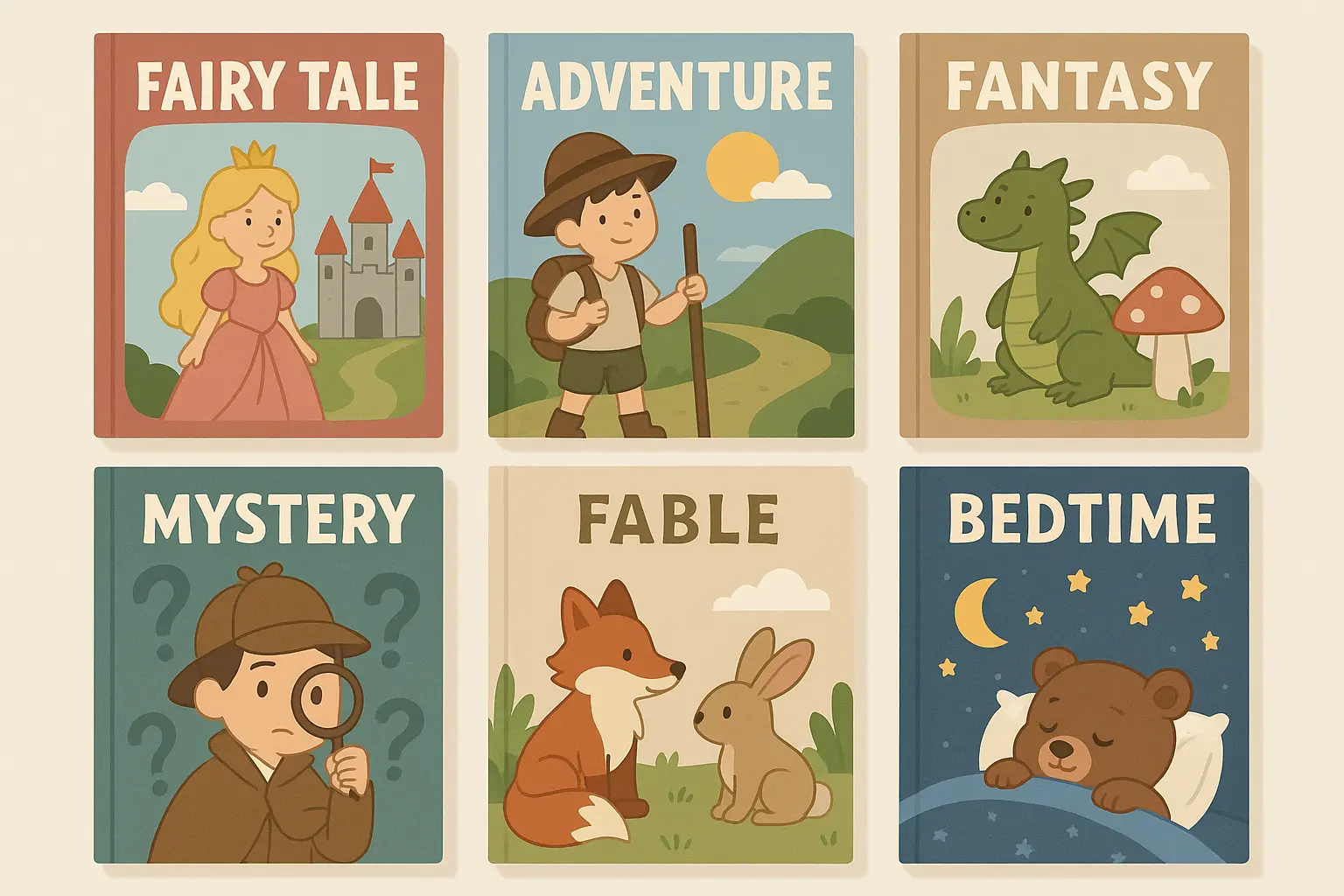
Stories for Kids Who Love Animals
Let’s face it, most kids love animals. These five stories use woodland creatures and pets to explore themes of cooperation, patience, curiosity, and family bonds without being preachy about it.
1. The Sleepy Forest Friends
This one’s about woodland animals getting ready for winter hibernation. My kids love how all the animals help each other out—it’s a sweet way to talk about teamwork without being obvious. Plus, it naturally makes everyone feel cozy and ready for sleep.
The story follows squirrels gathering nuts, bears finding cozy dens, and rabbits storing vegetables for spring. As autumn progresses, the forest community comes together for one final celebration before settling into their peaceful winter sleep.
2. Luna the Night Owl’s Lullaby
An owl helps other forest creatures find peaceful sleep through her soothing songs and gentle wisdom. Luna discovers that being awake at night can actually be helpful—she uses her natural nighttime wakefulness to comfort friends who struggle with bedtime fears. It’s perfect for kids who think being different is a problem.
3. The Traveling Turtle’s Dream
A slow-moving turtle discovers that the journey matters more than getting there fast. While other animals rush past, the turtle notices beautiful details and makes real friendships along his path. Great for impatient kids who need to learn that good things take time.
4. Whiskers and the Moonbeam
A curious cat follows a moonbeam through a magical nighttime adventure that ultimately leads back home. Whiskers meets nocturnal creatures who share wisdom about finding comfort in familiar places after exploring new experiences. It balances adventure with the security of home perfectly.

5. The Bear Family’s Bedtime Routine
A cozy story showing how a bear family winds down for their long winter sleep. Papa Bear, Mama Bear, and Little Bear each help with their preparation ritual. It mirrors human bedtime routines while incorporating the natural hibernation cycle, helping kids understand that rest is natural and necessary.
Magical Stories That Won’t Give Them Nightmares
Fantasy elements capture kids’ imagination while providing safe spaces to explore complex emotions. These five magical stories use dream weavers, fallen stars, and enchanted objects to address themes of hope, belonging, and creativity within frameworks that feel magical but safe.
These fantasy stories draw inspiration from traditional folktale storytelling techniques that have helped kids process emotions for generations.
6. The Dream Weaver’s Gift
This one’s about a magical person who creates custom dreams for kids. It sounds fancy, but it’s actually perfect for kids who have nightmares or worry about stuff. My daughter used to stress about school presentations, and after we read this story, she started asking the Dream Weaver to send her “brave dreams.” It’s sweet and actually seems to help.
The story follows the Dream Weaver’s process of selecting elements from a worried child’s daily life—her beloved dog, grandmother’s garden, and favorite book—weaving them into a transformative dream where fears become beautiful butterflies.
7. The Star That Fell to Earth
A fallen star learns about friendship and belonging while trying to find its way back to the sky. During its earthbound journey, the star discovers that helping others creates its own form of light and purpose. It’s great for kids who feel like they don’t fit in anywhere.
8. The Enchanted Library
Books come alive at night in a magical library. When ten-year-old Sam gets locked in after closing time, he discovers that storybook characters gather to share tales from their own worlds. Charlotte from “Charlotte’s Web” and Max from “Where the Wild Things Are” teach Sam that stories live in the hearts of their readers. Perfect for kids who already love books.
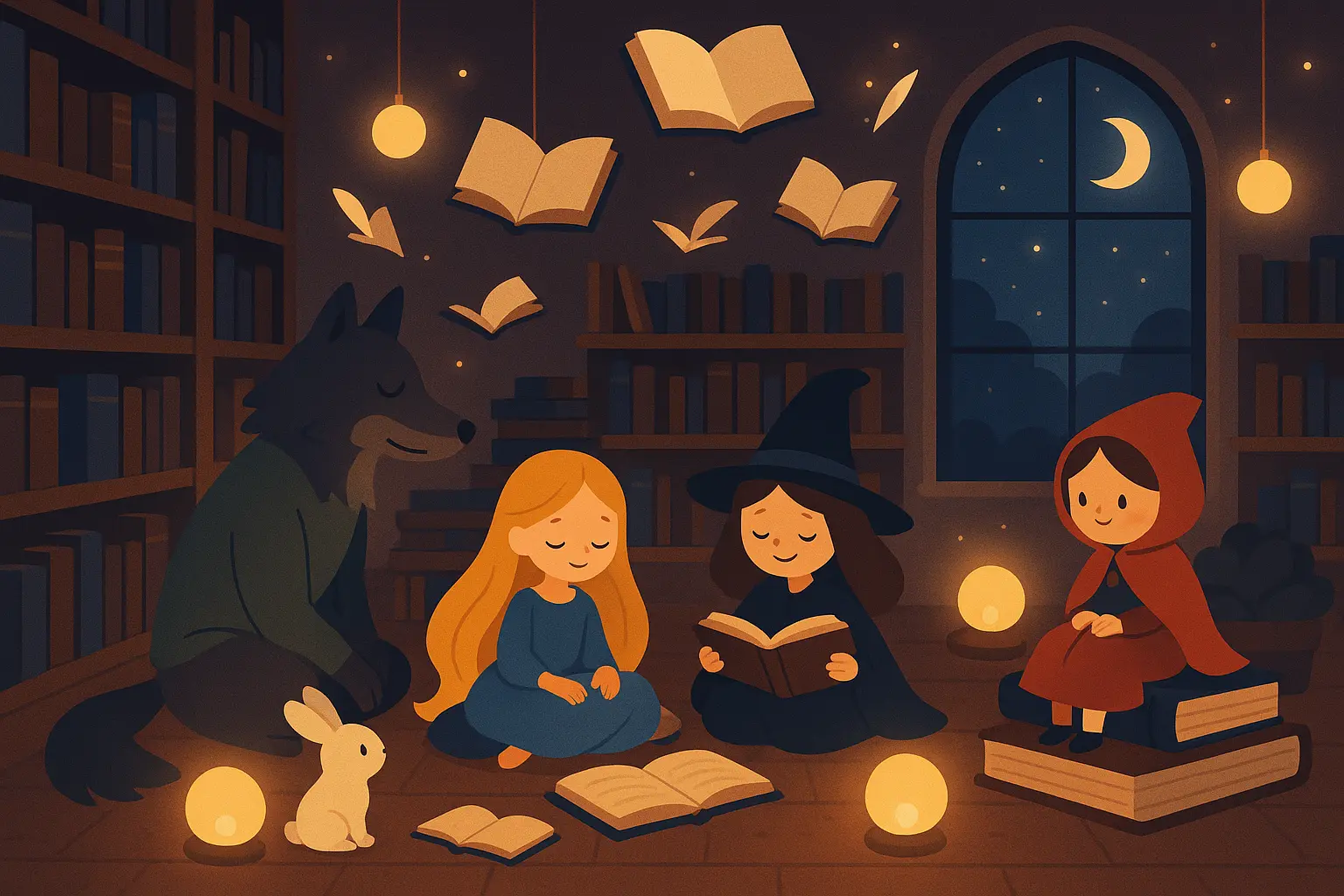
9. The Gentle Dragon’s Tea Party
A misunderstood dragon prefers tea parties to treasure hoarding. When village children discover the dragon’s true nature, they learn that appearances can be deceiving and friendship comes in unexpected forms. Great for addressing judgment and acceptance.
10. The Magic Paintbrush
A child discovers a paintbrush that brings drawings to life, but learns about responsibility and creativity when the magical creations cause unintended problems. It balances the excitement of magical abilities with lessons about thinking things through.
Real-Life Stories for Kids Who Think Fantasy is ‘Babyish’
These four stories ground kids in relatable, everyday experiences while finding wonder in ordinary moments. They address common childhood situations through realistic scenarios that feel familiar and comforting.
11. Grandpa’s Garden Secrets
A child learns about patience and growth while helping their grandfather tend a special garden. Each plant teaches different lessons about nurturing, waiting, and celebrating small victories. The intergenerational relationship is really sweet and shows how family wisdom gets passed down.
12. The Neighborhood Helper
This one’s about a kid who finds joy in small acts of kindness throughout their community. From helping elderly neighbors with groceries to feeding stray cats, the young protagonist discovers how small actions create positive ripple effects.
Seven-year-old Marcus was struggling with feeling too small to make a difference in his community. After reading “The Neighborhood Helper” together, he started his own “kindness jar” where he collected coins from helping neighbors with small tasks. By the end of the month, he had enough to buy birdseed for the community garden, proving that small actions really do add up.
13. The Rainy Day Discovery
Siblings turn a disappointing rainy day into an adventure of indoor exploration and creativity. When outdoor plans are cancelled, they discover hidden treasures in their own home and create new games together. Perfect for teaching flexibility and sibling cooperation.
14. The New School Friend
A gentle story about overcoming shyness and making new friendships. The story follows realistic social interactions and shows how small acts of kindness can bridge the gap between strangers. Great for kids facing new social situations.
Nature Stories That Actually Put Them to Sleep
Nature-based stories provide inherently calming content through natural imagery and gentle rhythms that mirror the peaceful aspects of the natural world. These four selections use ocean waves, mountain sounds, nocturnal gardens, and flowing water to create meditative experiences.
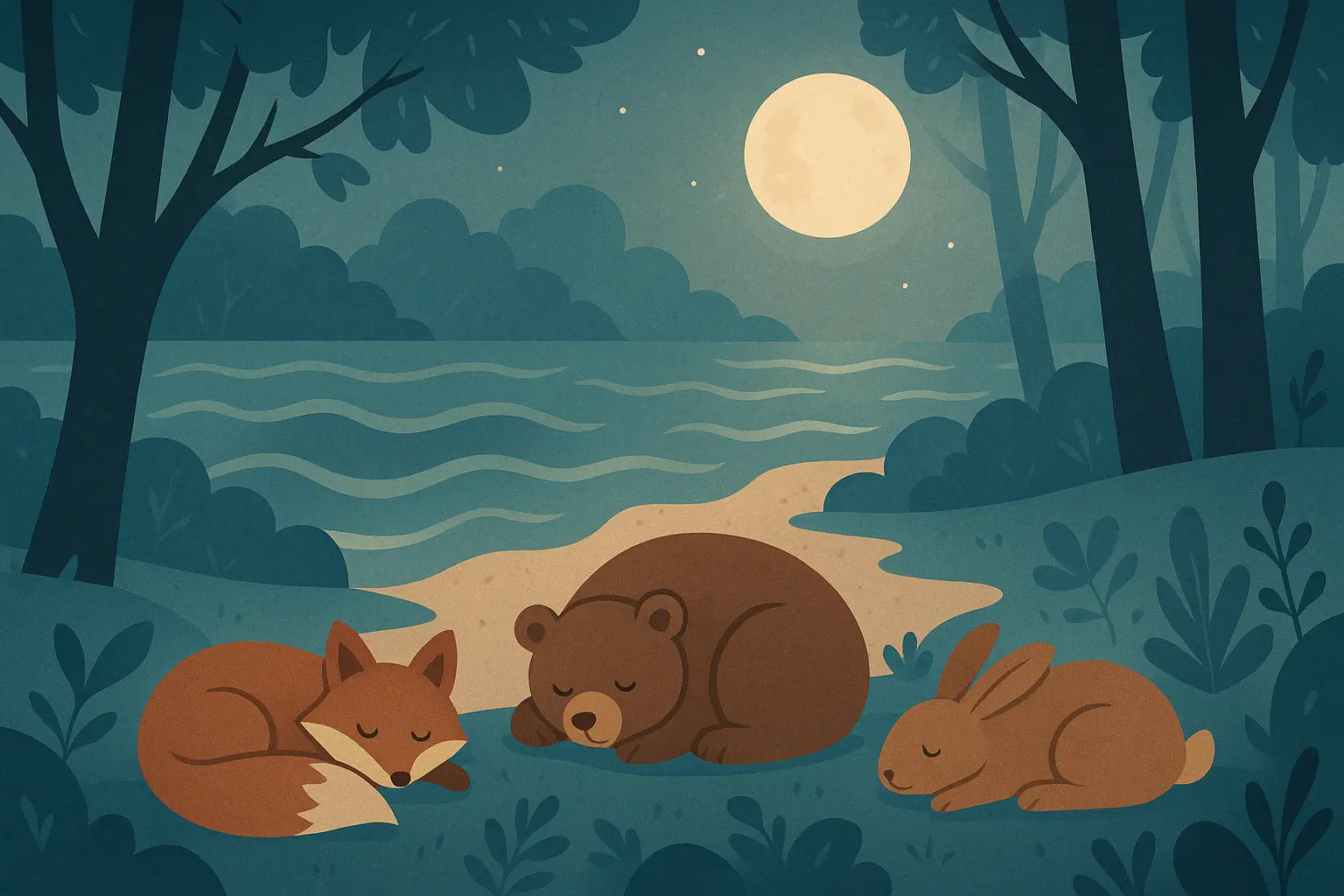
15. The Ocean’s Lullaby
Waves, sea creatures, and coastal sounds create a peaceful bedtime atmosphere. The story follows the gentle rhythm of tides while introducing kids to marine life. The natural sound patterns and flowing descriptions help children relax while learning about ocean ecosystems.
16. The Mountain’s Quiet Song
A story that follows the peaceful sounds and sights of a mountain from sunrise to sunset. Kids experience the mountain’s daily rhythm through the eyes of various creatures who call it home. It emphasizes stillness and natural beauty.
17. The Flower Garden’s Night Shift
Nocturnal pollinators and night-blooming flowers show the beauty of nighttime in nature. Kids discover that gardens remain active after dark, with moths, bats, and night-blooming plants creating their own magical world. Helps kids see nighttime as active and beautiful rather than scary.
18. The River’s Journey to the Sea
A gentle water cycle story that follows a river’s peaceful path from mountain spring to ocean destination. The flowing narrative structure mirrors the movement of water while teaching about geography and ecosystems.
Family Stories That Make Everyone Feel Warm and Fuzzy
These four stories explore the fundamental relationships that provide security and meaning in kids’ lives. Through tales of family traditions, shared projects, cultural heritage, and friendship milestones, these stories reinforce the importance of human connections.
19. The Grandmother’s Quilt
Each square of a handmade quilt tells a family story, emphasizing heritage and love across generations. As grandmother and grandchild examine each patch, family history comes alive through stories of ancestors and traditions. Really sweet for connecting kids with their family history.
20. The Shared Treehouse
Neighboring children learn to compromise and share while building their dream treehouse together. Initial disagreements about design and rules give way to creative problem-solving and stronger friendships. Great for teaching practical conflict resolution.
21. The Family Recipe
A child learns to cook a special family dish, discovering the ingredients that make a house a home. Beyond measuring and mixing, the young cook learns about family traditions and cultural heritage. Perfect for families who love cooking together.
22. The Sleepover Adventure
Friends navigate the excitement and slight nervousness of a first sleepover with understanding and support. The story addresses common sleepover concerns while showing how friends can help each other feel comfortable in new situations.
Stories for Anxious Kids
These three stories provide kids with practical tools for emotional regulation and self-awareness while maintaining the gentle, calming tone essential for bedtime reading. They address common childhood challenges through accessible techniques.
23. The Breathing Cloud
A cloud teaches a child about mindful breathing and finding calm in busy moments. Through gentle exercises and cloud-inspired imagery, kids learn practical techniques for managing overwhelming emotions. The story includes interactive breathing exercises that can be practiced during reading.
24. The Mirror Lake
A young person discovers self-acceptance and inner beauty through reflections in a magical lake. The lake shows not just physical appearance but also kindness, creativity, and other inner qualities that make each person special. Great for building positive self-image.

25. The Worry Stone
A child learns to manage bedtime worries with the help of a special stone and breathing techniques. When nighttime fears arise, the worry stone provides a tangible tool for processing and releasing anxious thoughts. Offers practical anxiety management strategies while validating that everyone worries sometimes.
Two Story Examples That Show the Range
Here are two detailed examples that show the range available in quality short bedtime stories. “The Dream Weaver’s Gift” represents more complex fantasy stories with rich imagery, while “The Bear Family’s Bedtime Routine” shows how simple, relatable stories can be equally effective.
These examples showcase the storytelling principles and narrative techniques that make bedtime stories both engaging and effective.
“The Dream Weaver’s Gift” – Why My Kids Love It
In a realm between sleep and waking, the Dream Weaver sits at her cosmic loom, threading together wisps of hope, memories, and imagination. Each night, she carefully crafts personalized dreams for children around the world, selecting materials based on each child’s needs and experiences.
When young Maya has been experiencing nightmares about starting at a new school, the Dream Weaver notices her distress through the silver threads that connect all sleeping minds. She begins weaving a special dream tapestry, selecting golden threads of courage from a brave knight’s story, silver strands of comfort from a mother’s lullaby, and rainbow fibers of joy from children’s laughter.
The Dream Weaver incorporates familiar elements from Maya’s life—her loyal golden retriever Max, her grandmother’s sunflower garden, and her favorite book about ocean adventures. She weaves these into a dream where Maya becomes a confident explorer discovering an enchanted island where fears transform into beautiful butterflies that carry messages of encouragement.
As Maya sleeps, she experiences this transformative dream journey. She meets other children who were once afraid but found their courage, and she discovers that her nervousness about new experiences actually shows how much she cares about doing well. When Maya wakes, she feels refreshed and ready to face her new school with confidence.
Best for: Kids who worry a lot or have bad dreams
Reading time: About 10 minutes
Parent warning: You might get requests to be the Dream Weaver yourself!
Simple and Sweet: “The Bear Family’s Bedtime Routine”
Papa Bear, Mama Bear, and Little Bear live in a cozy cave at the edge of Sleepy Hollow Forest. As autumn arrives and the first snow begins to fall, the bear family knows it’s time to prepare for their long winter sleep.
Papa Bear gathers the softest pine needles and moss for their beds, arranging them in a warm circle where the family can snuggle together. Mama Bear prepares one last hearty meal of honey, wild berries, and crunchy nuts, sharing stories about the adventures they’ll dream about during hibernation.
Little Bear helps by fluffing their sleeping area and saying goodnight to all their forest friends. He visits the wise old owl, waves to the busy squirrels storing their winter supplies, and promises the rabbits he’ll see them again in spring.
As they settle down together in their cave, Mama Bear tells Little Bear about the wonderful dreams they’ll share during their winter sleep—dreams of spring flowers blooming, babbling brooks flowing with fresh water, and warm sunshine on their fur. The family snuggles close, listening to the gentle sound of snow falling outside their cave, and drifts off into peaceful hibernation knowing they’ll wake up to a beautiful spring filled with new adventures.
Best for: Younger kids who love routine and family togetherness
Reading time: About 7 minutes
Why it works: Mirrors actual bedtime routines while feeling cozy and safe
How I Think About These Stories
Here’s how I decide whether a story actually works:
-
Can I read it in under 15 minutes without my voice giving out?
-
Will my kid actually sit still for it?
-
Does it calm them down instead of riling them up?
-
Will I lose my mind if they ask for it every single night for two weeks straight?
If the answer is yes to all of these, it’s a keeper.
|
Story Type |
My Top Pick |
Reading Time |
Best Ages |
Why It Works |
|---|---|---|---|---|
|
Animal Stories |
The Sleepy Forest Friends |
8-10 minutes |
3-8 years |
Cooperation without being preachy |
|
Fantasy Tales |
The Dream Weaver’s Gift |
10-12 minutes |
4-10 years |
Addresses fears, builds confidence |
|
Real-World |
Grandpa’s Garden Secrets |
7-9 minutes |
5-10 years |
Family bonds, patience |
|
Nature Stories |
The Ocean’s Lullaby |
8-11 minutes |
2-12 years |
Naturally relaxing sounds |
|
Family Stories |
The Grandmother’s Quilt |
9-11 minutes |
4-12 years |
Heritage, love across generations |
|
Anxiety Help |
The Breathing Cloud |
6-8 minutes |
4-12 years |
Practical tools they can actually use |
What Makes “The Dream Weaver’s Gift” Special
Length: Perfect at 8-10 minutes—long enough to get invested, short enough that tired kids can make it through.
Age Range: Works for ages 4-10 because younger kids love the magic while older kids appreciate the deeper themes about facing fears.
Emotional Impact: Validates kids’ anxieties about new experiences while showing them they can transform challenges into growth.
Why Kids Ask for It Again: The magical elements and detailed descriptions reveal new things with each reading. Plus, kids often request this story when facing their own challenges.
Why “The Breathing Cloud” Is a Game-Changer
Interactive Elements: The story includes breathing exercises that extend the reading experience while providing practical relaxation techniques.
Real-World Application: Kids learn concrete techniques for managing anxiety and stress that work beyond bedtime.
Growing Value: The breathing techniques become more effective with practice, so the story gets better with repetition.
Universal Appeal: Simple breathing concepts work for younger children, while older kids understand the emotional regulation strategies.
Using AI to Create Personal Bedtime Stories
Okay, let’s talk about something that might sound futuristic but is actually pretty cool—using AI to create bedtime stories. I know, I know, it sounds weird at first. But hear me out.
You know how your kid goes through phases? One month they’re obsessed with dinosaurs, the next it’s unicorns, then suddenly they only want stories about kids who look exactly like them? AI can actually help with that. Instead of buying a new book every time their interests change, you can create stories that star your actual kid dealing with whatever they’re going through right now.
Modern AI addresses common bedtime story challenges by providing personalized content that maintains the calming qualities essential for effective bedtime reading.
Parents can explore AI-powered bedtime story creation tools that generate personalized narratives while keeping those essential calming elements.
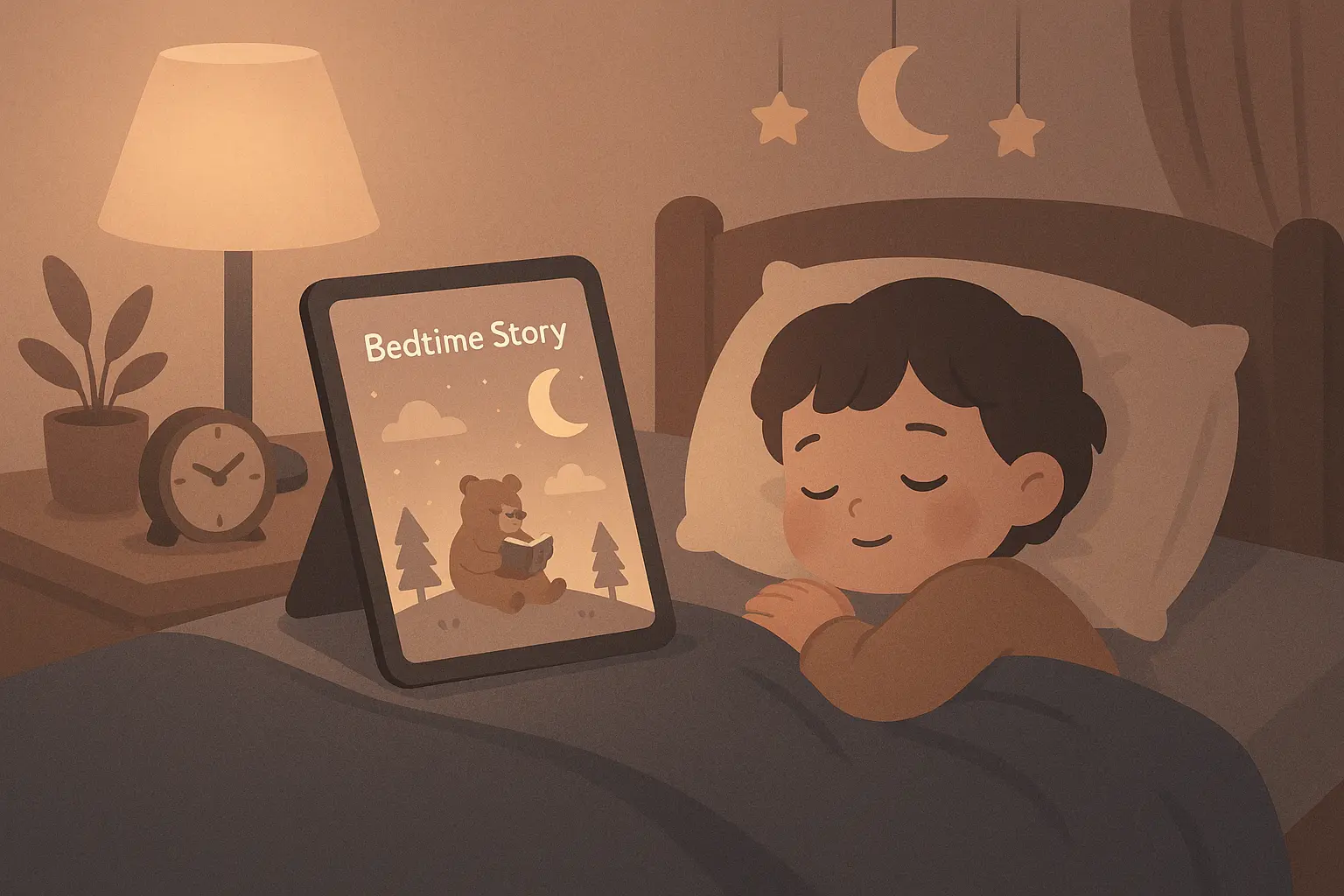
Real Problems AI Actually Solves
The “We’ve Read This 50 Times” Problem
Kids love familiar stories, but honestly, adults get bored. AI can create new variations on beloved themes, keeping the comfort of familiar elements while introducing fresh details that keep you engaged too.
Maybe your child loves stories about friendly dragons, but you’ve exhausted every dragon book at the library. AI can generate new dragon adventures that incorporate your child’s specific interests—a dragon who loves soccer or one who helps kids with homework.
Growing Pains
As kids grow, their interests change fast. AI understands these developmental changes and can generate stories that perfectly match your child’s current vocabulary, emotional needs, and interests without you having to research what’s age-appropriate.
Addressing Real Fears
When kids develop new fears or face challenging situations, you need stories that address these concerns within a comforting framework. AI can craft personalized narratives that help children process emotions through storytelling.
If your child suddenly becomes afraid of thunderstorms, AI can create a gentle story about a character who learns to find comfort during storms, incorporating your child’s name and familiar elements from their daily life.
When 5-year-old Sophia developed a fear of the dark after moving to a new house, her mother used AI to create a personalized story featuring Sophia as a brave night explorer who discovers that darkness is actually filled with gentle, helpful creatures. The AI incorporated details about Sophia’s new bedroom, her stuffed elephant, and her love of purple colors. After just three nights of reading this customized story, Sophia began asking to turn off her nightlight so she could “see the friendly night creatures better.”
How This Actually Works in Real Life
For families looking to expand beyond traditional options, exploring comprehensive short story examples can provide inspiration for creating personalized bedtime narratives.
Your Kid as the Hero
AI story tools can create content featuring your child as the protagonist, along with their pets, family members, and favorite activities. This personalization increases engagement while maintaining that calming tone that’s essential for bedtime.
Travel and Routine Chaos
When you’re away from home or dealing with schedule changes, AI ensures you always have access to familiar, comforting story elements while introducing just enough novelty to maintain interest.
Learning Without Lecturing
AI can seamlessly weave learning opportunities into entertaining narratives, creating stories that support development while maintaining the soothing tone essential for bedtime reading.
Cultural and Family Traditions
For families wanting to include cultural elements, family traditions, or diverse perspectives in their bedtime stories, AI can generate content that reflects your family’s unique background and values.
|
What You Get |
Traditional Books |
AI Stories |
When It’s Perfect |
|---|---|---|---|
|
Personalization |
Fixed characters |
Your kid as the star |
Building confidence, specific fears |
|
Flexibility |
Same story every time |
Adjusts to mood/age |
Growing with development |
|
Variety |
Limited by what you own |
Unlimited variations |
Preventing boredom |
|
Customization |
One-size-fits-all |
Tailored to interests |
Special needs, cultural inclusion |
|
Availability |
Need physical books |
Always there |
Travel, disrupted routines |
Whether you’re seeking inspiration for custom stories or looking to understand what makes narratives compelling, exploring diverse story theme examples can help you create more meaningful bedtime experiences.
Whether you’re a parent trying to enrich your bedtime routine, an educator developing classroom resources, or a caregiver looking for engaging short bedtime stories, AI tools provide the creative partnership you need to craft meaningful, memorable narratives that transform bedtime into a cherished daily adventure.
The Honest Truth About Bedtime Stories
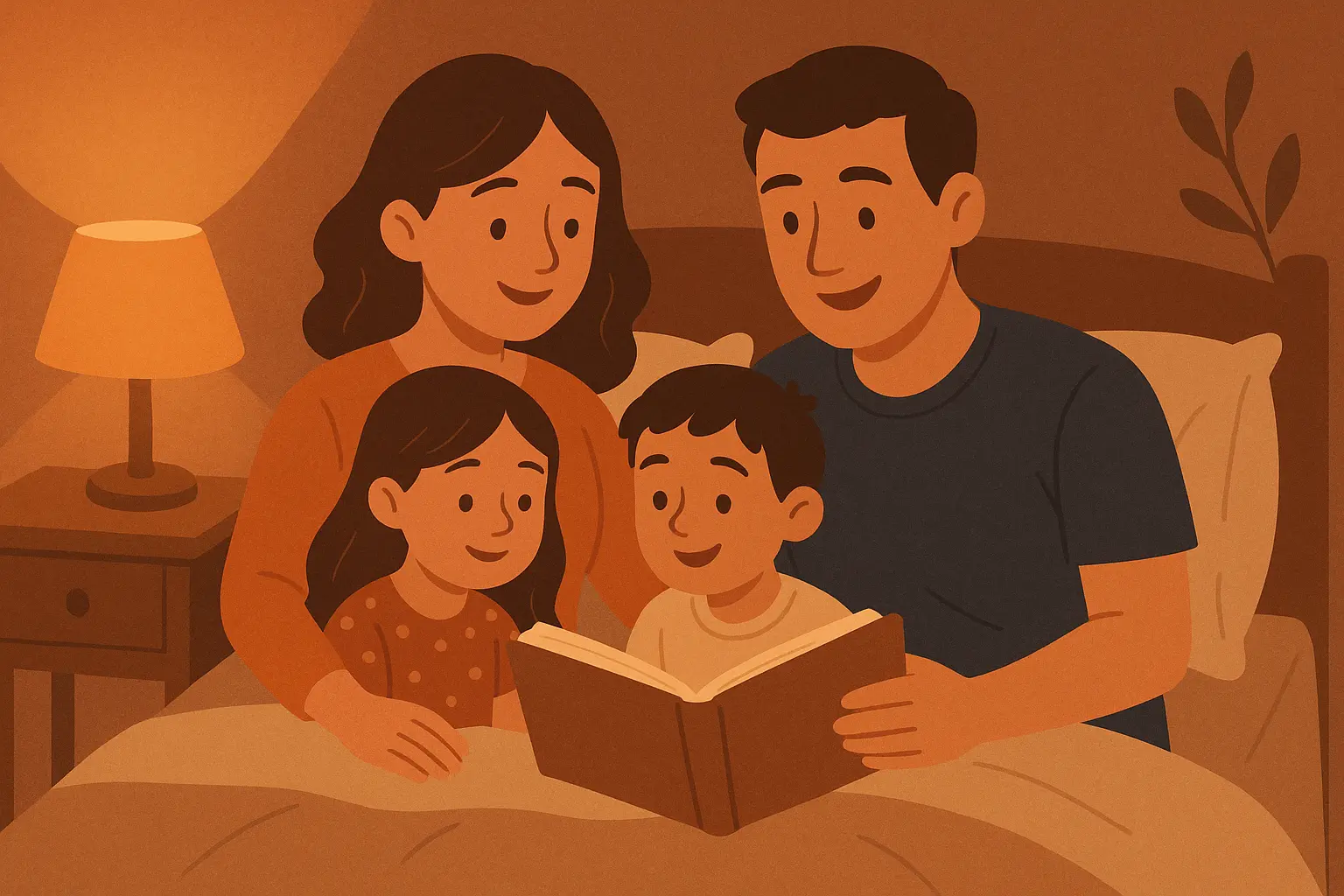
Look, I’m not going to pretend that the right bedtime story will solve all your nighttime battles. Some kids are natural sleepers, others fight it tooth and nail. But having a collection of stories that actually work—stories that calm instead of excite, that feel special without being overstimulating—that’s like having a secret weapon in your parenting toolkit.
The 25 bedtime stories in this guide represent more than just entertainment options—they’re tools for building stronger family connections, supporting emotional development, and creating positive associations with sleep and reading. Each story has been tested in real homes with real kids who have real opinions about what works and what doesn’t.
Remember that the most effective bedtime story is one that resonates with your specific child’s needs, interests, and developmental stage. Some kids will gravitate toward magical fantasy tales, while others prefer realistic scenarios or nature-based narratives. Pay attention to which stories your child requests repeatedly—these preferences often indicate emotional needs or developmental interests.
The truth is, some nights you’ll read the perfect story and your kid will drift off like an angel. Other nights, they’ll be bouncing around asking “what happens next?” even after the most boring story ever. That’s just kids being kids.
The combination of carefully selected traditional stories and modern AI-generated personalized content creates a comprehensive approach to bedtime reading that can grow and adapt with your family. Whether you choose classic tales from this list or create custom stories using AI tools, the key is consistency, engagement, and maintaining that crucial calming tone that helps children transition peacefully from day to night.
Start with a few from this list that match your kid’s personality. Keep the ones that work, ditch the ones that don’t. And remember, the best bedtime story is the one that gets read with love, even if you’re mumbling through it half-asleep yourself.
Bedtime stories are an investment in your child’s literacy development, emotional well-being, and your family’s daily connection. In our technology-driven world, these quiet moments of shared storytelling become even more precious and impactful. Make them count, but don’t stress if some nights you just wing it with a made-up story about a talking toothbrush. What matters is showing up, slowing down, and giving your kids those few precious minutes of your undivided attention. Trust me, they’ll remember these moments long after they’ve outgrown bedtime stories.



Add comment